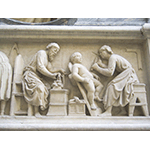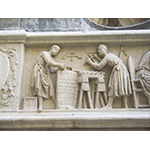Orsanmichele
The building was erected between 1337 and 1404 on the ruins of a thirteenth-century building. The unique construction consisted of a loggia, originally used as grain market, closed in the second half of the 14th century and converted into a church. The two upper floors maintained their function as grain storage until the second half of the 16th century. Halfway between the religious complex of Santa Maria del Fiore and the political complex of Piazza della Signoria, Orsanmichele constitutes a perfect example of civil-religious integration, reaffirmed by the tabernacles outside with statues of the patron saints of the Guilds (or Corporations of Trades). Among these, the Tabernacle of the Four Crowned Saints, realised by Nanni di Banco, holds particular interest under the technical-scientific profile. Sculpted for the Minor Guild of Stone and Wood Masters, which joined all of the workers in the building trade, the tabernacle niche hosts the monumental statues of four Saints (Castorius, Simpronian, Nicostratus and Simplicius). The bas-relief depicts the Saints at work: the first on the left builds a wall, the second holding a drill, works on a column, the third with compass and square, makes a capital, while the last one sculpts a putto with a pick or mattock. In addition to the tools used by the Saints, others hanging on the wall recreate the setting: the square, straight-edge, compass, and plumb-rule which, positioned on the left of the viewer, makes it possible to read the inclination of the surface on which it rests.
There was also talk of making Orsanmichele the site of astronomical research. In the 18th century, the Imperial Council of Regency entrusted astronomer Tommaso Perelli with the task of evaluating the suitability of the building to institute an astronomical observatory there. Though the stability and dimensions of the building proved suited, the same could not be said of the site. «Were the choice up to me – wrote Perelli – I would be inclined to the hill of Arcetri, a place ennobled by the observations and many-year sojourn of the great Galileo and thus worthy to serve, also in the centuries to come, the practise of a science that owes its most important advancements to the fatigues and ingeniousness of that truly incomparable man».
****************************
Texts by Graziano Magrini
English translation by Victor Beard
Last update 30/gen/2008





